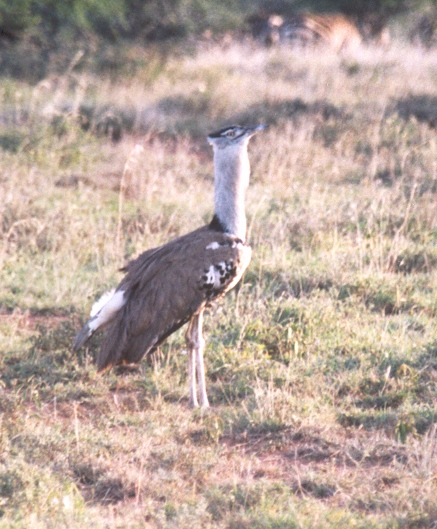|
| Query: Chlamydotis undulata macqueenii | Result: 4th of 4 | |
Bustard (Family: Otididae) - Wiki
| Subject: | Bustard (Family: Otididae) - Wiki
| |

| Resolution: 437x529
File Size: 160161 Bytes
Upload Date: 2007:11:22 14:37:18
|
Bustard
From Wikipedia, the free encyclopedia
Order: Gruiformes
Family: Otididae
[Photo] Kori Bustard (Ardeotis kori). Taken by Duncan Wright (http://commons.wikimedia.org/wiki/User:Sabine%27s_Sunbird). | Permission is granted to copy, distribute and/or modify this document under the terms of the GNU Free Documentation License, Version 1.2 or any later version published by the Free Software Foundation; with no Invariant Sections, no Front-Cover Texts, and no Back-Cover Texts. A copy of the license is included in the section entitled "GNU Free Documentation License". |
Bustards are large terrestrial birds mainly associated with dry open country and steppes in the Old World. They make up the family Otididae (formerly known as Otidae).
Bustards are omnivorous and nest on the ground. They walk steadily on strong legs and big toes, pecking for food as they go. They have long broad wings with "fingered" wingtips, and striking patterns in flight. Many have interesting mating displays.
Bustards are gregarious outside the breeding season, but are very wary and difficult to approach in the open habitats they prefer. Most species are declining or endangered through habitat loss and hunting, even where they are nominally protected.
Some Indian bustards are also called Floricans. The origin of the name is unclear. Jerdon writes in his bird of India (1862)I have not been able to trace the origin of the Anglo-Indian word Florikin, but was once informed that the Little Bustard in Europe was sometimes called Flanderkin. Latham gives the word Flercher as an English name, and this, apparently, has the same origin as Florikin.
???Jerdon's Birds, 2nd ed. ii. 625. The Hobson-Jobson dictionary however casts doubt on this theory stating thatWe doubt if Jerdon has here understood Latham correctly. What Latham writes is, in describing the Passarage Bustard, which, he says, is the size of the Little Bustard: Inhabits India. Called Passarage Plover. … I find that it is known in India by the name of Oorail; by some of the English called Flercher. (Suppt. to Gen. Synopsis of Birds, 1787, 229. Here we understand the English to be the English in India, and Flercher to be a clerical error for some form of floriken. Two great bustard (Otis tarda) eggs were recently laid in Britain for the first time since Queen Victoria was a child, but were unfertilized???probably owing to the still juvenile male population. The last bustard died out in Britain in about 1832, but the bird is being reintroduced through batches of chicks imported from Russia.
Species in taxonomic order
Great Bustard, Otis tarda
Arabian Bustard, Ardeotis arabs
Kori Bustard, Ardeotis kori, subspecies kori and struthinuclus
Great Indian Bustard, Ardeotis nigriceps
Australian Bustard, Ardeotis australis
Houbara Bustard, Chlamydotis undulata, subspecies undulata and fuertaventurae
Macqueen's Bustard, Chlamydotis macqueenii
Ludwig's Bustard, Neotis ludwigii
Stanley Bustard, or Denham's Bustard, Neotis denhami
Heuglin's Bustard, Neotis heuglinii
Nubian Bustard, Neotis nuba
White-bellied Bustard, Eupodotis senegalensis
Blue Bustard, Eupodotis caerulescens
Karoo Bustard, Eupodotis vigorsii
R??ppell's Bustard, Eupodotis rueppellii
Little Brown Bustard, Eupodotis humilis
Savile's Bustard, Lophotis savilei
Buff-crested Bustard, Lophotis gindiana
Red-crested Bustard, Lophotis ruficrista
Black Bustard, Afrotis afra
White-quilled Bustard, Afrotis afraoides
Black-bellied Bustard, Lissotis melanogaster
Hartlaub's Bustard, Lissotis hartlaubii
Bengal Florican, Houbaropsis bengalensis
Lesser Florican, Sypheotides indica
Little Bustard, Tetrax tetrax
http://en.wikipedia.org/wiki/Bustard
| The text in this page is based on the copyrighted Wikipedia article shown in above URL. It is used under the GNU Free Documentation License. You may redistribute it, verbatim or modified, providing that you comply with the terms of the GFDL. |
|
 |

|

|
Chlamydotis undulata macqueenii
4/4 |
 |
 |
^o^
Animal Pictures Archive for smart phones
^o^
|
|